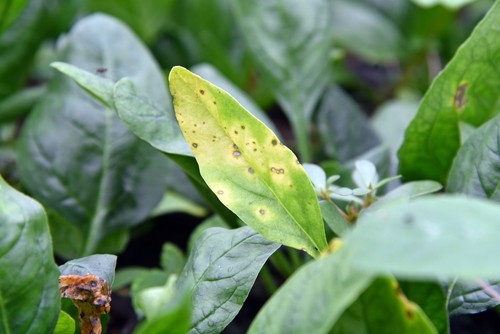Black spots on spinach leaves can be a common issue for gardeners and farmers alike. These spots can be caused by a variety of factors, ranging from environmental conditions to pests and diseases. Identifying the cause of the black spots is crucial in determining the best course of action for prevention and treatment.
One of the most common causes of black spots on spinach leaves is fungal diseases such as Cercospora leaf spot. This disease is caused by the fungus Cercospora beticola and can affect a variety of plants including beets, Swiss chard, and spinach.
Leaf spots caused by this fungus are typically circular with a tan or gray center and a purple or reddish-brown border.
In addition to fungal diseases, black spots on spinach leaves can also be caused by insects and pests such as aphids and leafminers. The spinach leafminer, for example, can create mines in the leaves that eventually turn into irregular blotched areas.
Environmental conditions such as high humidity and nutrient deficiencies can also contribute to the development of black spots on spinach leaves.
Also read:
Identifying Black Spots on Spinach Leaves
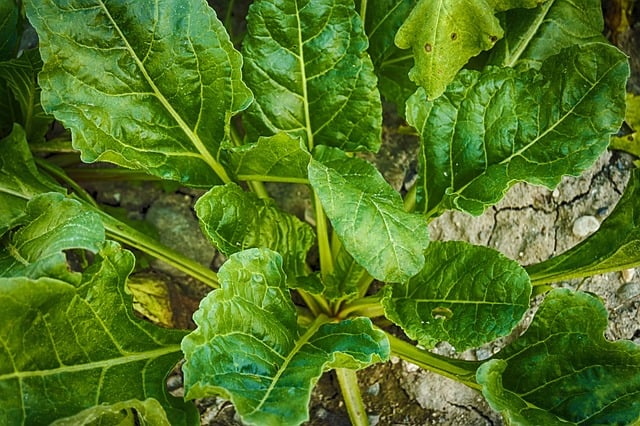
Black spots on spinach leaves can be caused by several factors, including fungal diseases, pests, or environmental factors. Identifying the cause of the black spots is crucial in treating the issue and preventing further damage to the spinach plants.
Physical Characteristics
Black spots on spinach leaves are usually circular or irregular in shape and can vary in size. These spots are typically black or dark brown in color and may have a slightly raised or sunken appearance. In some cases, the black spots may also have concentric rings or black dots within them.
Associated Symptoms
In addition to black spots, spinach leaves affected by fungal diseases may also have yellow spots, lesions, or discoloration. Pests such as aphids and flea beetles can cause small holes or pits in the leaves and may also leave behind a sticky residue or honeydew.
Environmental factors such as overwatering or high humidity can also contribute to the development of black spots on spinach leaves.
It is important to note that not all black spots on spinach leaves are harmful. Some spots may be caused by natural pigments or bruising and do not affect the quality or safety of the spinach. However, if the black spots are widespread and accompanied by other symptoms, it is best to take action to prevent further damage to the plants.
In conclusion, identifying black spots on spinach leaves is crucial in determining the cause of the issue and taking appropriate action to treat and prevent further damage.
By understanding the physical characteristics and associated symptoms of black spots on spinach leaves, growers can effectively manage their spinach crops and maintain healthy plants.
Common Diseases Causing Black Spots
Spinach plants are susceptible to various diseases that can cause black spots on their leaves. Here are some of the most common diseases that can cause black spots on spinach leaves:
1. Downy Mildew
Downy mildew is a fungal disease caused by Peronospora farinosa f. sp. spinaciae that can cause black spots on spinach leaves. It thrives in cool, wet conditions and can spread rapidly through the plant, causing leaves to curl and die.
The disease can be identified by the appearance of yellow patches on the upper surface of the leaves, which later turn brown and black as the disease progresses. Downy mildew can be controlled by planting resistant varieties, rotating crops, and avoiding overhead irrigation.
2. Anthracnose

Anthracnose is a fungal disease caused by Colletotrichum dematium that can cause black spots on spinach leaves. The disease can be identified by the appearance of small, circular, sunken spots on the leaves, which later turn black and develop a papery texture.
Anthracnose can be controlled by planting resistant varieties, avoiding overhead irrigation, and practicing good sanitation.
3. Cercospora Leaf Spot
Cercospora leaf spot is a fungal disease caused by Cercospora beticola that can cause black spots on spinach leaves. The disease can be identified by the appearance of small, circular, grayish-brown spots on the leaves, which later turn black and develop a papery texture.
Cercospora leaf spot can be controlled by planting resistant varieties, avoiding overhead irrigation, and practicing good sanitation.
4. White Rust
White rust is a fungal disease caused by Albugo occidentalis that can cause black spots on spinach leaves. The disease can be identified by the appearance of white, powdery spots on the undersides of the leaves, which later turn black as the disease progresses.
White rust can be controlled by planting resistant varieties, rotating crops, and avoiding overhead irrigation.
5. Fusarium Wilt
Fusarium wilt is a fungal disease caused by Fusarium oxysporum that can cause black spots on spinach leaves. The disease can be identified by the appearance of yellowing and wilting of the leaves, which later turn black as the disease progresses.
Fusarium wilt can be controlled by planting resistant varieties, avoiding overhead irrigation, and practicing good sanitation.
Role of Insects and Pests
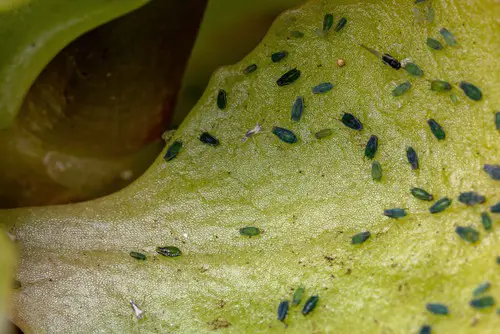
Insects and pests are common culprits of black spots on spinach leaves. These tiny creatures can cause significant damage to the plant, leading to reduced yields and poor quality produce. Here are some of the most common pests that can cause black spots on spinach leaves:
1. Aphids
Aphids are small insects that feed on the sap of the plant. They are commonly found on the underside of leaves and can cause significant damage to the plant if left untreated. Aphids excrete a sticky substance called honeydew, which can attract other pests and lead to the growth of sooty mold on the spinach leaves.
2. Flea Beetles
Flea beetles are small, dark-colored beetles that can jump like fleas. They feed on the leaves of the plant, leaving small holes that can eventually lead to black spots. Flea beetles are most active in the spring and can be controlled with insecticides.
3. Armyworms and Cabbage Loopers
Armyworms and cabbage loopers are the larvae of moths. They feed on the leaves of the plant, causing extensive damage. These pests can be controlled with insecticides or by using natural predators such as parasitic wasps.
4. Spinach Crown Mite
Spinach crown mites are microscopic pests that feed on the roots of the plant. They can cause significant damage to the plant, leading to stunted growth and black spots on the leaves. Spinach crown mites can be controlled with insecticides or by using natural predators such as predatory mites.
5. Wireworms
Wireworms are the larvae of click beetles. They feed on the roots of the plant, causing stunted growth and black spots on the leaves. Wireworms can be controlled with insecticides or by using natural predators such as ground beetles.
To prevent black spots on spinach leaves caused by pests and insects, it is essential to practice good crop management techniques. This includes planting disease-resistant varieties, rotating crops, and using insecticides and other pest control measures when necessary.
Influence of Environmental Conditions
Spinach is a cool-season crop that prefers moderate temperatures and moist soil conditions. However, when environmental conditions are not optimal, spinach may develop black spots on its leaves.
1. Soil Conditions

Soil moisture is a crucial factor affecting the growth and quality of spinach. If the soil is too dry, spinach may become stressed, which can lead to the development of black spots. On the other hand, if the soil is too wet, it can cause root rot, which can also lead to black spots on the leaves.
Therefore, it is important to maintain proper soil moisture levels to prevent black spot development.
2. Temperature and Humidity
Spinach prefers moderate temperatures between 60-65°F (15-18°C) for optimal growth. High temperatures can cause stress to the plant and increase the risk of black spot development. Additionally, high humidity levels can create ideal conditions for fungal growth, which can cause black spots on the leaves.
3. Water Stress
Water stress can also cause black spots on spinach leaves. When the plant is not receiving enough water, it can become stressed, which can cause the leaves to develop black spots. Therefore, it is important to ensure that spinach plants receive adequate water to prevent water stress.
In summary, environmental conditions such as soil moisture, temperature, humidity, and water stress can all influence the development of black spots on spinach leaves.
Maintaining proper soil moisture levels, avoiding high temperatures and humidity, and ensuring that spinach plants receive adequate water can help prevent black spot development.
Impact of Nutrient Deficiency

Spinach plants require a range of essential nutrients to grow and produce healthy leaves. Nutrient deficiencies can cause various issues, including black spots on spinach leaves. Here are some of the most common nutrient deficiencies and their impact on spinach plants:
1. Phosphorus Deficiency
Phosphorus is an essential nutrient that plays a crucial role in plant growth and development. A deficiency of phosphorus can cause black spots on spinach leaves, stunted growth, and poor root development. Spinach plants with phosphorus deficiency may have dark green leaves with a purple tint.
2. Iron Deficiency
Iron is another essential nutrient that spinach plants require for healthy growth. A lack of iron can cause black spots on spinach leaves and yellowing of the leaves. Iron-deficient spinach plants may also have stunted growth and reduced yields.
3. Calcium Deficiency
Calcium is important for cell wall development and helps prevent diseases in spinach plants. A lack of calcium can cause black spots on spinach leaves and tip burn. Calcium-deficient spinach plants may also have distorted leaves and stunted growth.
4. Potassium Deficiency
Potassium is essential for plant growth and helps regulate water balance in spinach plants. A deficiency of potassium can cause black spots on spinach leaves and yellowing of the leaves. Potassium-deficient spinach plants may also have stunted growth and reduced yields.
5. Fertilizer
Fertilizer is crucial for spinach plants to grow and produce healthy leaves. A lack of fertilizer can cause nutrient deficiencies and black spots on spinach leaves. It is essential to provide spinach plants with the appropriate type and amount of fertilizer to avoid nutrient deficiencies and other issues.
Prevention and Treatment Methods

Black spots on spinach leaves can be prevented and treated using a variety of methods. Here are some tips to keep your spinach healthy and free from black spots:
- Rotate Crops: Crop rotation is an effective way to prevent the buildup of diseases in the soil. By rotating crops, you can prevent the same plant family from growing in the same spot for two or more years in a row. This helps to break the disease cycle and keep your soil healthy.
- Use Disease-Free Seed: Using certified disease-free seed can help prevent the spread of diseases, including those that cause black spots on spinach leaves. Be sure to purchase seed from a reputable source and check for any signs of disease before planting.
- Practice Good Maintenance: Good maintenance practices, such as removing infected plant debris and keeping the area clean and weed-free, can help prevent the spread of diseases. Regularly inspect your plants for any signs of disease and take action immediately if you notice any symptoms.
- Avoid Overhead Irrigation: Overhead irrigation can promote the spread of diseases, including those that cause black spots on spinach leaves. Instead, use a drip irrigation system or water at the base of the plant to keep the foliage dry.
- Use Fungicides: Fungicides can be used to prevent and treat black spots on spinach leaves. Be sure to choose a fungicide that is labeled for use on spinach and follow the instructions carefully.
- Use Organic Methods: Organic methods, such as using compost and other natural soil amendments, can help keep your soil healthy and prevent the buildup of diseases. Additionally, using organic methods can help reduce the need for chemical treatments.
- Hot Water Treatment: Hot water treatment can be used to kill pathogens on seed or plant material. This method involves immersing the seed or plant material in hot water for a specific amount of time to kill any pathogens that may be present.
By following these prevention and treatment methods, you can help keep your spinach healthy and free from black spots.
Importance of Disease-Free Seeds
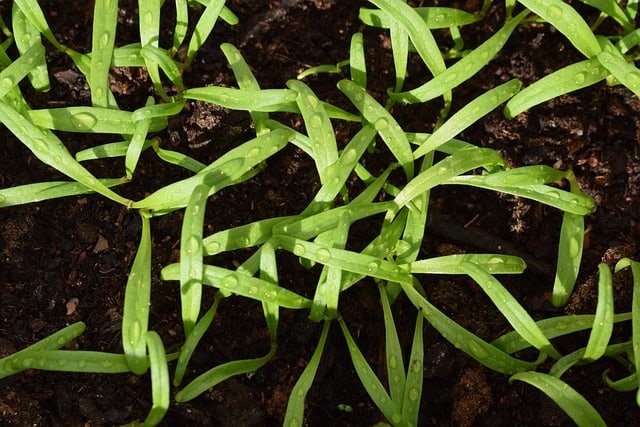
Using disease-free seeds is crucial for spinach growers to prevent black spots on spinach leaves. Black spots on spinach leaves can be caused by various pathogens, including fungi, bacteria, and viruses.
These pathogens can be transmitted through infected seeds, soil, water, or other plant materials. Therefore, starting with disease-free seeds is the first step in preventing black spots on spinach leaves.
Using certified disease-free seeds is highly recommended for spinach growers. Certified seeds are tested and proven to be free of pathogens that can cause diseases. They are produced under strict quality control standards to ensure their purity and germination rate.
Using certified seeds can reduce the risk of introducing diseases to the field and increase the yield and quality of the crop.
Germination is also an essential factor in preventing black spots on spinach leaves. Poor germination can lead to weak and vulnerable seedlings that are more susceptible to diseases. Therefore, using high-quality seeds with a high germination rate is crucial for spinach growers.
In addition to using certified disease-free seeds, spinach growers should also follow good agricultural practices to prevent the spread of diseases. This includes using clean tools and equipment, practicing crop rotation, and avoiding planting spinach in areas with a history of diseases.
Role of Proper Irrigation
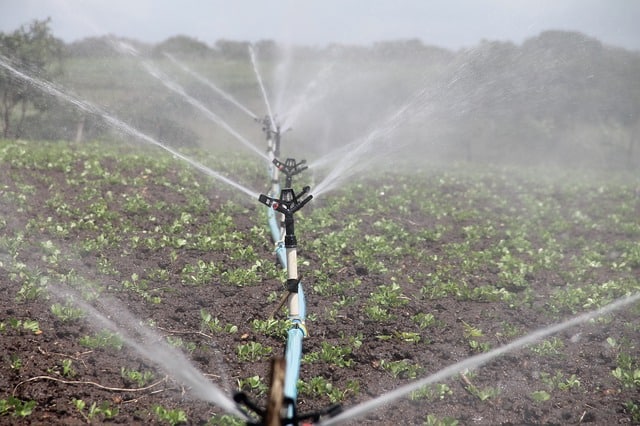
Proper irrigation is essential in preventing black spots on spinach leaves. Overhead irrigation should be avoided as it can lead to moisture on the leaves, which can promote the growth of fungal spores. Drip irrigation or other forms of irrigation that apply water directly to the soil are recommended.
It is also important to use clean irrigation water. If the irrigation water is contaminated with fungal spores, it can lead to the development of black spots on the leaves. Therefore, the source of irrigation water should be monitored and treated if necessary.
In addition, the timing of irrigation is crucial. Spinach should not be irrigated during the late afternoon or evening as this can lead to prolonged leaf wetness, which can promote the growth of fungal spores. Instead, irrigation should be done in the early morning to allow the leaves to dry quickly.
Proper irrigation can also help prevent other diseases that can cause black spots on spinach leaves. For example, overwatering can lead to root rot, which can weaken the plant and make it more susceptible to disease.
Dealing with Infected Crops
When spinach plants are infected with black spot leaf disease, it is important to take action to prevent the spread of the disease and minimize damage to the crop. Here are some steps to take:
- Remove and destroy infected leaves: Infected leaves should be pruned and removed immediately to prevent the spread of disease. Ensure the overall health of the plant by removing diseased leaves entirely. To prevent the spread of disease through contact with the plant or soil, throw them away immediately with your regular trash before doing any more work in the area.
- Keep the garden clean: To prevent the spread of disease, it is important to keep the garden clean. Remove any debris, fallen leaves, or weeds that may harbor disease-causing organisms. Sanitize equipment regularly to prevent the spread of disease.
- Use a fungicide: Fungicides can be used to control the spread of black spot leaf disease. Follow the instructions on the label carefully and apply the fungicide as directed.
- Rotate crops: Crop rotation is an effective way to prevent the buildup of disease-causing organisms in the soil. Rotate crops every year to prevent the buildup of disease organisms in the soil.
- Plant resistant varieties: Some spinach varieties are resistant to black spot leaf disease. Consider planting resistant varieties to reduce the risk of disease.
By taking these steps, gardeners can effectively deal with infected crops and prevent the spread of black spot leaf disease.
Frequently Asked Questions
Are black spots on spinach leaves safe to eat?
Black spots on spinach leaves are usually not harmful to eat, but they can affect the taste and texture of the spinach. However, it is best to remove any heavily spotted leaves before consuming them.
How to treat black spots on spinach leaves?
The best way to prevent black spots on spinach leaves is to avoid overwatering and to provide good air circulation around the plants. If black spots do appear, remove the affected leaves and discard them.
Fungicides may also be used to treat severe cases, but it is best to consult a professional before using any chemicals on edible plants.
What causes brown spots on spinach leaves?
Brown spots on spinach leaves can be caused by a number of factors, including fungal diseases such as downy mildew or leaf spot, insect damage from pests like flea beetles or leafminers, or environmental stress such as drought or high temperatures.
What are the dark dots on spinach leaves?
The dark dots on spinach leaves are likely to be spores of fungal pathogens that cause leaf spot diseases. These spores can spread easily and cause further damage to the plant if not addressed promptly.
How do you treat black spots on spinach?
To treat black spots on spinach, remove the affected leaves and discard them. Fungicides may also be used to treat severe cases, but it is best to consult a professional before using any chemicals on edible plants.
Is it okay to eat spinach with spots?
It is generally safe to eat spinach with spots, but it is best to remove any heavily spotted leaves before consuming them. Additionally, if the spots are caused by a fungal disease, it is possible that the disease could spread to other parts of the plant or to other plants in the garden.

Hey, I’m Lisa and I’ve been an avid gardener for over 30 years. I love writing, talking and living in the garden! Feel free to connect with me on my socials below

